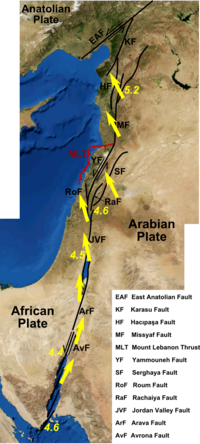
The Dead Sea Transform (DST) fault system, also sometimes referred to as the Dead Sea Rift, is a series of faults that run for about 1,000 km from the Maraş triple junction (a junction with the East Anatolian Fault in southeastern Turkey) to the northern end of the Red Sea Rift (just offshore of the southern tip of the Sinai Peninsula).[2] The fault system forms the transform boundary between the African plate to the west and the Arabian plate to the east. It is a zone of left lateral (sinistral) displacement, signifying the relative motions of the two plates.[3] Both plates are moving in a general north-northeast direction, but the Arabian plate is moving faster, resulting in the observed left lateral motions along the fault of approximately 107 km at its southern end. A component of extension is also present in the southern part of the transform, which has contributed to a series of depressions, or pull-apart basins, forming the Gulf of Aqaba, Dead Sea, Sea of Galilee, and Hula basins. A component of shortening affects the Lebanon restraining bend, leading to uplift on both sides of the Beqaa valley. There is local transtension in the northernmost part of the fault system, forming the Ghab pull-apart basin. The southern part of the fault system runs roughly along the political border of Lebanon and Israel on its western side, and southern Syria and Jordan on the eastern side.
- ^ Cite error: The named reference
Gomez_2007was invoked but never defined (see the help page). - ^ Sadeh, M.; Hamiel, Y.; Ziv, A.; Bock, Y.; Fang, P.; Wdowinski, S. (2012). "Crustal deformation along the Dead Sea Transform and the Carmel Fault inferred from 12 years of GPS measurements". Journal of Geophysical Research: Solid Earth. 117 (B8). Bibcode:2012JGRB..117.8410S. doi:10.1029/2012JB009241.
- ^ Al-Zoubi, Abdallah S.; Abu-Hamatteh, Z.S.H.; Abdealkaderer, Amrat (2006). "The seismic hazard assessment of the Dead Sea rift, Jordan". Journal of African Earth Sciences. 45 (4–5): The Dead Sea rift is a sinistral transform plate boundary separating the Sinai sub-plate in the west (part of African plate) and the Arabian plate in the east. Bibcode:2006JAfES..45..489A. doi:10.1016/j.jafrearsci.2006.04.007.